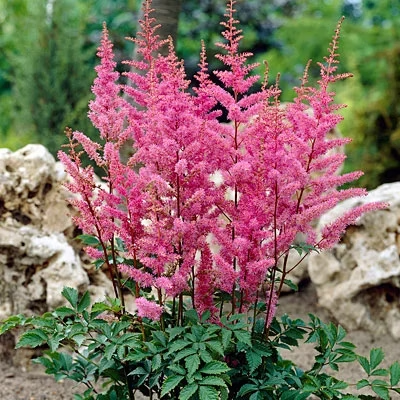
Astilbe
Botanical Name
:
Astilbe spp.
Plant Type
:
Herbaceous perennial
Seasons
:
Plant in spring or fall; Blooms in summer and spring
Sun Level
:
Partial shade to full shade
Ideal Soil Temperature for Planting
:
Flourish in temperatures between 60–75°F (15–24°C)
Soil Type
:
Loamy, moist
Hardiness Zones
:
4–9 (USDA)
Germination
:
The best way to grow Astilbe is through division every 2–3 years in spring or fall. Seeds take longer to germinate and bloom (6 to 8 weeks), making division the quicker option.
P.H. Level
:
Slightly acidic soil pH of around 6.0
Water/Irrigation
:
Constant moisture
Fertilization
:
Regular fertilization (especially phosphorus); choose a 5-10-5 or 10-10-10 ratio fertilizer
Habit
:
Clump-forming
Propagation
:
Division, seeds
Final Plant Height
:
1–4 ft
Spread
:
2 ft
Flowers
:
Plume-like flowers in shades of white, pink, red, and lavender (6” in length)
Attracts
:
Butterflies, hummingbirds, birds
Uses
:
Floral arrangements, shade gardens, and woodland borders
Companions
:
Hostas, holy ferns, and heuchera
Pruning
:
Remove faded flowers as they wilt throughout the season
Toxicity
:
Non-toxic to humans but can lead to mild gastrointestinal upset in dogs if consumed excessively
Pests
:
Trouble-free; groundhogs and rabbits may feed on new growth
Diseases
:
It can develop powdery mildew in humid weather conditions.
Additional Info
:
Keep soil consistently moist, especially in summer
Botanical Name
:
Astilbe spp.
Plant Type
:
Herbaceous perennial
Seasons
:
Plant in spring or fall; Blooms in summer and spring
Sun Level
:
Partial shade to full shade
Ideal Soil Temperature for Planting
:
Flourish in temperatures between 60–75°F (15–24°C)
Soil Type
:
Loamy, moist
Hardiness Zones
:
4–9 (USDA)
Germination
:
The best way to grow Astilbe is through division every 2–3 years in spring or fall. Seeds take longer to germinate and bloom (6 to 8 weeks), making division the quicker option.
P.H. Level
:
Slightly acidic soil pH of around 6.0
Water/Irrigation
:
Constant moisture
Fertilization
:
Regular fertilization (especially phosphorus); choose a 5-10-5 or 10-10-10 ratio fertilizer
Habit
:
Clump-forming
Propagation
:
Division, seeds
Final Plant Height
:
1–4 ft
Spread
:
2 ft
Flowers
:
Plume-like flowers in shades of white, pink, red, and lavender (6” in length)
Attracts
:
Butterflies, hummingbirds, birds
Uses
:
Floral arrangements, shade gardens, and woodland borders
Companions
:
Hostas, holy ferns, and heuchera
Pruning
:
Remove faded flowers as they wilt throughout the season
Toxicity
:
Non-toxic to humans but can lead to mild gastrointestinal upset in dogs if consumed excessively
Pests
:
Trouble-free; groundhogs and rabbits may feed on new growth
Diseases
:
It can develop powdery mildew in humid weather conditions.
Additional Info
:
Keep soil consistently moist, especially in summer
Written by Nondiah Khalayi – https://www.linkedin.com/in/nondiah-khalayi/

